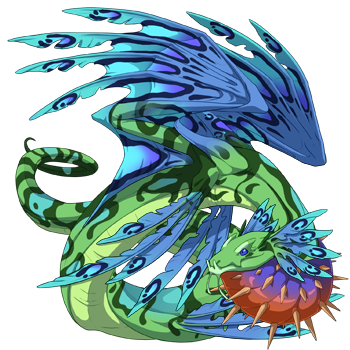#eel gene
Text

Hunter/Watermelon/Shamrock
#flight rising#dragon share#scrying workshop#fae#flight rising fae#savannah gene#eel gene#peacock gene#nature flight
21 notes
·
View notes
Text

November 10, 2023:
Rose Secondary, Skydancer, Eel.
Solace of BladeDancer's clan!
29 notes
·
View notes
Text











Scries of some of my dragons (or project dragons) as Undertides!
The last two are my progens!
#missy rambles#my lair#dragon share#scrying workshop#fr undertide#poison gene#eel gene#plating gene#lionfish gene#foam gene#ringlets gene#boa gene#saddle gene#sailfin gene#nudibranch gene#octopus gene#rings gene#facet gene#ghost gene#trail gene#marble gene#pufferfish gene
6 notes
·
View notes
Text


Skydancer or wildclaw?
2 notes
·
View notes
Text

Bleed dry a heart of bloody stone. This is all you were ever meant to be; still you mourn.
Com for Loreshark
#flight rising#frfanart#dragon art#fr undertide#flightrising#my art#these have been sitting in my drafts#aaaaaaaah I think I'm finally free of the curse#headaches and sickness#anyway i was so excited for this guyyyyyy oh my gosh#i don't have many undertides so i don’t draw them often but i have sketched so many and have a really fleshed out design for the breed#i will be fixing that btw#i love fish dragons so much they just didn’t have enough genes for me#they do now :)#they are mainly based off eels which i love so much#such an incredible animal
242 notes
·
View notes
Text
Ancient Parchment
I'm seeing a lot of chatter about the new MP tab split for ancients (and for good reason!!) but I also want to make sure that everyone saw the update section about gene parchment.
Activities like Baldwin/Swipp/Coli/Arlo/Avery will not drop breed-specific genes. Instead, the Ancient version that would drop will instead be a "Parchment" for that gene. Instead of Blossom (Gaoler) or Blossom (Undertide), you will now receive an Ancient Gene Parchment: Blossom.
One you have a parchment, you take that to Glass and Gloss to trade for the specific breed you need. It doesn't seem like all ancient genes from these activities have parchments yet, but there is a lot of steps going on here to help address the ancient gene bloat.
#flight rising#maybe i haven't crawled through enough of frblr to see people mentioning this#but everyone seems excited about new eel genes AND the long awaited MP split#but now!! we're finally getting universal versions we can trade in
74 notes
·
View notes
Text

Yeah but damn, Adrian tho..!! Bonfire beach party timeee..!!!
#flight rising#my lair#i forgot i got him all his genes!!! hes so fun :D#also ALSO!!!!!#I'll show yall soon but i figured out what I'll do with my undertide scrolls!!!!! very cool eels coming up!!!!
16 notes
·
View notes
Photo




hey check out my cool new eels
#flight rising#PROJECTS#eel projects#gonna take time to brew all these octo/rings genes but boy am I glad best gene is baldwin gene
17 notes
·
View notes
Text
New Flash Sale: Secondary Dusthide Gene: Eel
A new flash sale has been discovered for Secondary Dusthide Gene: Eel
A scroll that will change the secondary gene of one Dusthide dragon to Eel. This item can only be used once and will disappear after it has been applied.
Game database: click here
Marketplace link: click here
Treasure: 77500 62000

#frtools#fr tools#flight rising#flightrising#fr#flash sale#flashsale#secondary dusthide gene: eel#secondary gene#gene#eel#ancient gene#dusthide
1 note
·
View note
Text
Understanding Regenerative Medicine
By Arjuwan Lakkdawala
Ink in the Internet
It started in the 50s with the first bone marrow transplant, and stem cell research has taken off with promising results and astonishing insights into cells and genes, and the remarkable way in which human and animal bodies function on the cellular level.
Regenerative medicine is being tested and explored in the treatment of several diseases including cancer and heart disease, two of the leading causes of deaths world wide, researchers also have hopes of finding treatments through it and learning about how Alzheimer's diseases can be treated and its degenerative effects. This is of significance considering the rise of Alzheimer's disease in the past twenty years. (I suspect mobile phones maybe the culprit, read my previous article.)
So what are stem cells exactly and how are they being used in regenerative medicine?
There are many types of function specific cells in the body, the stem cells being tested and used are basically of two main types. One is the embryonic stem cells that are taken from an human embryo which is 3 to 5 days old and has 150 cells, and is from an egg fertilised in vitro fertilisation clinic and has not been implanted in the uterus. It is without a doubt controversial as it raises questions of the ethics of this particular research.
Stem cells can also be found in umbilical cord blood, and the amniotic fluid, which fills the sac surrounding the fetus in the womb.
Women giving birth in hospitals should be notified if the umbilical cord blood is taken for stem cell collection.
These stem cells have the capability to differentiate (turn into) almost any function specific cell in the human body, making them highly favourable for testing and studying how they mature, they can also be frozen to be stored without getting damaged, and they are stable and durable.
Stem cells with the capability to differentiate are called pluripotent cells.
The other type are adult stem cells that have already differentiated into function specific cells, these are found in the bone marrow and fat in the body. While at first it was thought that their capabilities were limited in treatment or testing, scientists are discovering that adult stem cells are useful in many ways and are easier to match to a patient than embryonic stem cells. Because the body's immune system is most likely to attack embryonic stem cells from a donor than its own adult stem cells that have been reprogrammed for treatment.
However, adult stem cells could have defects due to environmental hazards or toxicity.
In both main stem cell types it is tools of reprogramming that is being developed.
In 2006, the Nobel Prize-winning scientist Shinya Yamanaka and his team, at Kyoto University in Japan, discovered how to revert adult stem cells into embryonic stem cell like state.
This is called Induced Pluripotent Stem Cells or iPSC.
The genes that define an embryonic stem cell are there in every cell in the body but they are turned off. Yamanaka pioneered the technique to turn on those genes in adult stem cells. He did it by injecting molecules in the adult stem cells with the instructions to turn on the embryonic stem cell genes, and by this changing the identity of the adult function specific stem cell into an embryonic like stem cell.
The instructions for gene reprogramming are in proteins or chemicals that mimic proteins that have been selected to alter the identity of the stem cells into the function specific cells required for potential treatment or testing.
For example, if a patient suffering from heart disease is injected with healthy stem cells that have been turned into heart cells, they could help treat the heart.
Or in the case of testing, new drugs can be tested on stem cells that have been differentiated into the cell type in the body targeted by the drugs. Scientists can study if the drug is effective at treating the cells or causes adverse affects. This is of course much better than testing the drugs on living humans or even animals. Animals have suffered so much because of lab testing. I hope stem cells would be a sufficient alternative to animal testing.
The other way in which stem cell research is very useful is that through it researchers and scientists can study cells otherwise inaccessible. Like for example neurons in the brain.
Stem cells can be differented into neuron like cells, they won't be exactly the same but very close proxies.
Studying stem cells that have been successfully turned into different types of cells of the body in a culture petri dish allows scientists to much easily observe the onset of diseases and test possible treatments. Stem cells are also being considered as alternatives to organ transplant, and tests are ongoing in this context.
The human body has regenerative abilities like the skin healing after wounds or hair growing back. But it is the liver that is most astonishing as it has cells that can regenerate while other organs in the body don't. Scientist are studying why this is.
However, regeneration in humans is nothing compared to some species in the animal kingdom. Like for example worms, lizards, salamanders, jellyfish.
Researchers at Whitehead Institute are studying regeneration, and Professor Peter Reddien, is especially focused on a type of flat worm that has remarkable regeneration capabilities. The worm planarian can regrow its whole body even when it has been cut into pieces. Each piece will grow into a whole new worm.
Another worm was introduced for studying and testing by Professor Mansi Srivastav, the model worm suitable for testing and experiments is the three-banded panther worm. Both worm species have regenerative capabilities and studies have shown that neoblasts (worm stem cells) in the muscles of the worms are guided by Position Control Genes PCGs into regenerating the whole worm from each piece.
Scientists are developing new techniques of the process of actually introducing proteins or chemicals acting like proteins into the cell membrane of the stem cells or adult stem cells to be reprogrammed.
The percentage of successful reprogramming so far is not high. Previously a virus was used to inject transcription instruction factors into stem cells. But this method was imperfect.
Newer methods include using a plasmid, a circular DNA construct to enter the stem cell membrane with the transcription instructions, after the cell has been zapped with an electric current that makes a temporary hole in it.
While this method of using electricity to change genes is used in labs, a recent study from the University of Nagoya in Japan, studied electric eels that were used to zap zebra fish, using an electric field, they found that the genes of the fish had changed.
The study was published in the journal PeerJ-Life Environment.
"Electric eels and other organism that generate electricity. Could affect genetic modification in nature," said Atsuo Lida, professor and author on the study.
We don't know if the 860 volts discharged from eels in the amazon river has contributed to gene transfer between species but it's a possibility.
The human genome has ca. 20,000 genes that construct proteins. Genes and proteins are the building blocks of life.
Therefore stem cell reprogramming is wholly based on using proteins or chemicals mimicking proteins to alter cells into function specific cell types.
However, the creation of new genes is just as much a mystery as the start of biological life.
A recent discovery by the University of Helsinki in Finland, has a possible answer to the mystery of the mechanism behind the making of new genes. The classical genes that make proteins have regulatory genes, and as the university was studying errors in DNA replication they found that a mutation event can give rise to the very tiny sort of sub-genes from which perhaps other larger genes are made.
Arjuwan Lakkdawala is an author and independent science researcher.
X/Instagram: Spellrainia Email: [email protected]
Copyright ©️ Arjuwan Lakkdawala 2024
Sources:
SciTech Daily - Palindromic Puzzles Solved: the Hidden Mechanism of Gene Creation, University of Helsinki
National Library of Medicine - Induced Pluripotent Stem Cells: Reprogramming Platforms and Applications in Cell Replacement Therapy, Akram Al Abbar, Stewart Ching Ngai, Nadine Nograles, Suleiman Yusuf Alhaji, Syahril Abdullah
Electric Eel Zaps can Change Fish DNA - Popular Mechanics, Tim NewComb
ISCRM - What is Cell Reprogramming
The Science of Self-Repair: Regeneration Research at Whitehead Institute by Greta Friar
Mayo Clinic Staff - Stem Cells: What are they and what do they do

#Arjuwan Lakkdawala#regenerative medicine#stem cells#cell reprogramming#gene editing#ink in the Internet#science#electric eels#adult stem cells#biology#nature
0 notes
Text

Blush/Aqua/Cerulean
#flight rising#dragon share#scrying workshop#undertide#flight rising undertide#lionfish gene#eel gene#sailfin gene#arcane flight
18 notes
·
View notes
Text

April 28, 2024:
Saffron Tertiary, Spiral, Eel.
Clyde of SliverOfStraw's clan!
3 notes
·
View notes
Text




Cringetober day 1
Heterochromia!!!!!
I still have to do another prompt but im so eepy💔
#cringetober#art#fursona#oc#she has thost blind and deaf white cat and electric eel genes in her#she uses electricity as her sight!!!#inktober#my foot is cold
1 note
·
View note
Text

lo and behold, it was NOT tidelord!!
#sure do love those *checks smudged writing on hand* undertales#going feral over these. waiting till tomorrow so i can acquire the last gene for my new eel
1 note
·
View note
Text
I bought more dragons during blackout hours last night and yeeeessssss NOW WERE TALKING!
THIS LAD is my personal favorite! I don't know if I'm keeping him or not but I know EXACTLY what kind of design I'm giving his gijinka

These other two I'll give designs to and probably flip.


#gene: what the fuck are veilspun genes#gene: shell#gene: web#gene: noxtide#gene: peacock#i might keep the imp too#shes awesome#i love ribbon and eel#i NEED more dragons with it
1 note
·
View note
Text

Jolts from electric eels cause fish to absorb free-floating DNA
Zebrafish larvae took up genes for fluorescent proteins and began to glow after swimming with eels.
Think of it as a sort of superhero origin story for zebrafish:
Getting zapped by electric eels can allow them to acquire new DNA—and new abilities—researchers reported yesterday in PeerJ. Scientists working with genetic engineering sometimes use electricity to open temporary holes in cell membranes to allow foreign DNA to enter.
To find out whether a version of this phenomenon can happen in nature, the team put electric eels (Electrophorus electricus, pictured) and larvae from zebrafish (Danio rerio) into a tank together, along with free-floating genes that code for a green fluorescent protein.
After a day swimming amid the eels’ electric shocks, some larvae started to glow green, New Scientist reports, indicating their cells had taken in and begun to express the foreign genes.
The newly acquired DNA degraded quickly—the larvae only glowed for about a week—but it caused scientists to wonder: Could a wild animal acquire genes in this way and pass them to its offspring?
Researchers aren’t yet sure, but if so, they say it could introduce new mutations that influence the species’ evolution.
via: https://www.science.org/content/article/jolts-electric-eels-cause-fish-absorb-free-floating-dna
672 notes
·
View notes